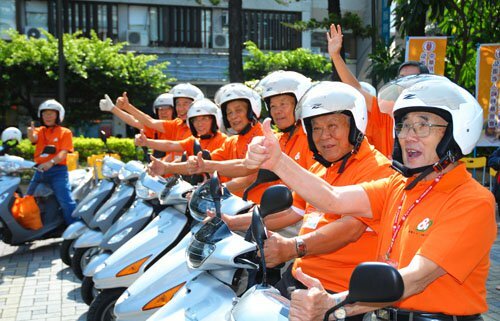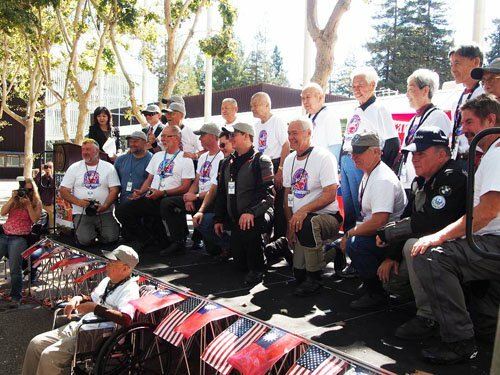On the morning of August 20, more than 100 Taiwanese-Americans, local residents and a dozen journalists packed the Santa Clara County Government Center Plaza in San Jose to attend a ceremony for the grandriders. The colors red, white and blue were prominently on display, coincidentally being the colors of the United States’ and the Republic of China’s (Taiwan) national flags. Hanging around the stage were banners proclaiming the occasion, “Grandriders’ West Coast kick off rider”. The audience was drawn from all age groups, young and old all drawn there to applaud theses motorcycling octogenarians.
Never too old to pursue a dream
The grandriders became known in Taiwan for their motorcycle ride around the island. The ride was subsequently made into a documentary, Go Grandriders, which featured 17 grandparents motorcycling around the island. Organized by the Hondao Senior Citizens Welfare Foundation, the ride started from Taichung (central Taiwan) and circled the whole island in 2007. The riders overcame physical and mental difficulties to complete the 730–mile trip. Their desire was to impart a clear message that you are “never too old to pursue a dream, or to cease to learn, or to experience something new.” Their trip and subsequent film became a major hit in Taiwan and Hong Kong, with devoted fans around the world.
Since the original trip, four of the riders have passed away, but the recent trip to the United States by ten of the remaining Grandriders appears to be echo another message that “we’re not done yet.” The grandriders decided to visit California, because most of them had never been to the US. They were offered the opportunity to take part in a road trip from San Jose to Los Angeles on Highway 1. So last month, the grandriders, their families and assorted medical support staff, arrived in the Bay Area for the ride. By now, the average age of the grandriders is 87 years old, with the oldest at 95. The group was all male, except for one lone female rider, Zhang Ying-mei. She and her husband had more prominent roles during this trip since they both speak English.
As the majority of the group does not speak English and the likelihood of passing an English driving test seemed close to nil, the grandriders had a dilemma. This is where the members of the BMW Club of Northern California stepped in to save the day by offering the grandriders a lift down south. Before long, there were more than enough American volunteer riders to pair up with each Taiwanese rider. Although, not as elderly as the grandriders, with an average age of 55, they were no less excited about the trip.
Instrumental in making the ride possible was Edward Perry, the captain of the motorcade. A former assistant sheriff of Santa Clara County, he was deeply moved after watching the documentary on YouTube. When Perry, whose wife is Taiwanese, found out that the Hondao Foundation had the idea of arranging a California trip for the grandriders, he quickly volunteered to plan the trip. With the full support of Z. Ortiz, president of the BMW Club of Northern California, Perry mobilized a team of American volunteers to form a motorcade and scouted out the route.
A liberating experience
Ortiz recalled that he was always confident the American volunteers would accomplish the journey, “but not as a task or some mundane chore.” He said, “When you have 10 Alpha-males in a group of motorcyclists there are bound to be some challenges, but when you make things about someone else, it is extremely liberating and it aligns everyone to the higher purpose instead of yourself.”
Escorted by the county sheriffs, the senior motorcade pulled away from the curb in front of the plaza promptly at 11:30 am, and straight up to Highway 1. Riding through Monterey, Santa Barbara and other places in between, they arrived in Los Angeles on August 23.
Before the West Coast trip, the grandriders stayed in the San Francisco Bay Area from August 16 to 19. They visited The Sequoias and On Lok, two very well-regarded organizations serving senior citizens, and took part in the Happy Kids Day in Cupertino, the San Jose International Film Festival and other activities. They also toured well-known tourist attractions in San Francisco.
The senior riders had fun and were surprised with so many things during their US trip. One said, “The US is huge. Americans are tall, the mountains are high and the ocean is big too.” Besides sightseeing, the grandriders also met with other seniors to share their experiences. According to Doris Lin, chief executive of the Hondao Foundation, many American seniors admired the riders’ tenacious energy. Despite the language barrier, the two sides communicated well enough through hugs and smiles.
Language not a barrier to mutual understanding
During the ride, San Jose resident Dan Carter rode with 85-year-old Sun Xiang-chun. Sun was originally from Shandong province, northern China and followed Chiang Kai-shek’s troops in withdrawing to Taiwan in 1949. Retired from the army in 1982, Sun served as a kindergarten bus driver and a condominium clerk. His hobby is traveling and photography. He never thought he would be able to take part in such a wonderful journey.
Carter only knew a few words in Mandarin, while Sun spoke no English at all. Carter said, “We tried to speak some Mandarin, and the grandriders were very polite and nodded at our humble attempts.” “So many things were universally understood; a beautiful view, the thrill of riding down the coast, photographs of our families.” Ortiz recalled although there was a language barrier when the grandriders had something to say, it was conveyed with alacrity. “Their eyes were very expressive and full of wisdom.”
As for his American counterparts, Perry noted, “I witnessed more selfless acts and acts of kindness than I can remember. And never once did I recall anyone trying to ‘take credit’ for anything good that may have happened. “I believe we all had the sense that we were part of something much bigger than ourselves and felt proud … to be a part of the journey.”
Asked how he thought of helping the grandriders, Kevin Kelly, a Vietnam War veteran, described the trip with them as “a gift from the Heaven”. He had played the documentary film to a dozen of his friends at his Sacramento residence before the trip, and all of them had tears in their eyes after watching it.
Perry stressed that the intrinsic reward the American volunteers received from the journey has made them richer and better people, something that cannot be measured.
Changing stereotypes of older people
Lin said that Taiwan has the world’s fastest growing aging population, and little time to prepare to deal with an aging society. She works to change the generally held perception that the elderly are sick and burdensome. She believes that the best way to deal with senior citizens is preventive care, that is, to encourage the elderly to live with a younger mind.
Lin hopes that the Taiwanese grandriders would help to change the stereotype of the elderly with their trips.
Huang Ma-chun, 81, is a retired civil servant from Nantou County in central Taiwan. He said that the purpose of his participation in this trip was to prove that someone elderly can still have a dream, and to act to realize that dream is to have a young heart.
Wang Zhong-tian, 83, a calligraphy teacher from Taichung, said the American riders took great care of the Taiwanese seniors during the trip. He was deeply touched by the profound friendship between the peoples of Taiwan and the US. Both countries are concerned with senior care. Even though the Taiwanese grandriders rode behind their American counterparts, the whole 430-mile journey still posed a major challenge for them. He said, “The Americans helped us to realize a dream. They are part of our courage.”









